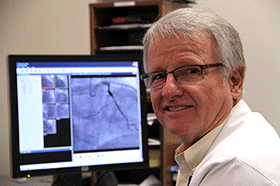Pulmonary Hypertension

The UK Gill Heart & Vascular Institute provides the region’s only expertise in the management of pulmonary hypertension. Many of our patients are referred from other area hospitals for treatment.
Our program includes a multidisciplinary team of cardiologists, pulmonologists and nurse practitioners who work together to help patients who suffer from this condition. For those who do not respond sufficiently to treatment, referral to our lung transplant specialists is provided.
Patient appointments
Request an appointment online or call one of the locations listed below.
Referrals
Health care providers, please visit our referral page to refer your patient to this service.
About pulmonary hypertension
Pulmonary hypertension (PH) is a condition of the lung — or pulmonary — blood vessels in which all the small pulmonary arteries thicken, and pulmonary artery blood pressure rises far above normal levels. There are highly effective treatments.
The World Health Organization divides pulmonary hypertension into five groups:
- Group 1, or pulmonary arterial hypertension (PAH)
- Group 2, PH secondary to disease of the left side of the heart
- Group 3, PH secondary to lung disease
- Group 4, chronic thromboembolic pulmonary hypertension (CTEPH)
- Group 5, other miscellaneous causes
Pulmonary hypertension of any cause forces the right ventricle – which pumps blood through the lungs – to work harder. That leads to the threat of right ventricular failure.
Idiopathic pulmonary arterial hypertension (iPAH, formerly primary pulmonary hypertension), means PAH of unknown cause. It is a severe form of WHO Group 1 PAH that occurs rarely, or about two of 100,000 new cases in the U.S. per year, though the actual number is unknown.
It is more common in women between the ages of 21 and 40, but it can develop at any age and in either men or women.
While the exact cause of iPAH remains uncertain, research suggests some people might be at greater risk because of genetics. Group 1 PAH can also be caused by collagen-vascular diseases such as scleroderma and rheumatoid arthritis, and other conditions such as HIV disease.
Emerging research also points to a defect in metabolism in the small pulmonary arteries, whose cause is unknown, which leads to PAH.
Symptoms of PH include the following and may resemble those of other conditions or medical problems:
- Shortness of breath (dyspnea)
- Chest pain
- Fatigue
- Swelling in the ankles or legs (edema)
- Dizziness
- Fainting spells (syncope) or seizure
- Bluish lips and skin (cyanosis)
- Racing pulse or palpitations, throbbing sensations due extra heart beats
Treatment
The goal of medical treatment for pulmonary hypertension is to relieve symptoms, reduce the workload on the right ventricle and prolong life. Specific treatment will be determined based on the results of testing (see below), especially right heart catheterization.
Cases of mild pulmonary hypertension may respond to conventional medications such as calcium channel blockers used in the treatment of essential hypertension. Anticoagulants are used in many PH patients to prevent blood clotting in the small pulmonary arteries. Diuretics reduce fluid accumulation if the right ventricle struggles with its workload.
While rarely used in left heart failure, digoxin may be used in PAH to improve the contraction of the right ventricle. Specialized drug therapy for PAH results in pulmonary vasodilation (or blood vessel relaxation), slows the thickening of the muscular lining of the small pulmonary arteries and improves survival.
Specialized drug therapy includes:
- Phosphodiesterase-5 inhibitors, including sildenafil and tadalafil
- Endothelin receptor antagonists, including bosentan and ambrisentan
- Prostanoids, including inhaled and continuously subcutaneous or intravenous drugs.
Additional treatments include:
- Supplemental oxygen delivered through nasal prongs or a mask
- Consideration for a lung or heart-lung transplantation
Research
Currently enrolling trials:
- OPUS
Trials in start-up:
- ADAPT Registry
- Southpaw 301/302
Trial in data analysis:
- Sildenafil in Heart Failure
Completed trials:
- IKARIA
- CAPTURE III
- Aries
- Stride 1 - 3
Recent publications from our team:
- Noel ZR, Kido K, Macaulay TE. Selexipag for the treatment of pulmonary arterial hypertension. Am J Health Syst Pharm. 2017 May 22. PMID: 28533253
- Ferraris VA. Increased understanding leads to increased complexity: Molecular mechanisms of pulmonary arterial hypertension. J Thorac Cardiovasc Surg. 2016 Oct;152(4):1188-90. PMID: 27394071
- Guglin M, Rajagopalan N, Anaya P, Charnigo R. Sildenafil in heart failure with reactive pulmonary hypertension (Sildenafil HF) clinical trial (rationale and design). Pulm Circ. 2016 Jun;6(2):161-7. PMID: 27252841
- Coz Yataco A, Aguinaga Meza M, Buch KP, Disselkamp MA. Hospital and intensive care unit management of decompensated pulmonary hypertension and right ventricular failure. Heart Fail Rev. 2016 May;21(3):323-46. PMID: 2648679
- Ballard-Croft C, Wang D, Jones C, Wang J, Pollock R, Jubak B, Topaz S, Zwischenberger JB. Resolution of pulmonary hypertension complication during venovenous perfusion-induced systemic hyperthermia application. ASAIO J. 2013 Jul-Aug;59(4):390-6. PMID: 23820278
- Hoopes CW, Gurley JC, Zwischenberger JB, Diaz-Guzman E. Mechanical support for pulmonary veno-occlusive disease: combined atrial septostomy and venovenous extracorporeal membrane oxygenation.
- Semin Thorac Cardiovasc Surg. 2012 Autumn;24(3):232-4. PMID: 23200082
- Cheng HY, Dong A, Panchatcharam M, Mueller P, Yang F, Li Z, Mills G, Chun J, Morris AJ, Smyth SS. Lysophosphatidic acid signaling protects pulmonary vasculature from hypoxia-induced remodeling. Arterioscler Thromb Vasc Biol. 2012 Jan;32(1):24-32. PMID: 22015657
- Zhou X, Wang D, Castro CY, Hawkins H, Lynch JE, Liu X, Zwischenberger JB. A pulmonary hypertension model induced by continuous pulmonary air embolization. J Surg Res. 2011 Sep;170(1):e11-6. PMID: 2169676






